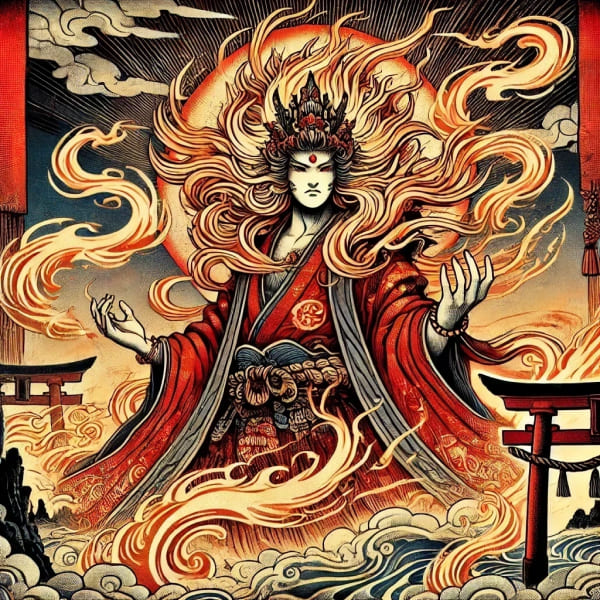Kagutsuchi: The Tragic Fire God of Japan and His Role in Creation and Purification

Contents
A blaze that gave life—and took it away. A god born in fire, whose flames consumed his own mother.
In Japanese mythology, few deities embody such raw power and tragic beauty as Kagutsuchi (Kagu-tsuchi-no-Kami), the fiery god whose birth set into motion both destruction and creation. Revered as the Shinto god of fire and purification, his myth begins in sorrow—born to the primordial gods Izanami and Izanagi, his very existence burned his mother to death.
Yet from this tragedy came rebirth: Kagutsuchi’s death gave rise to a host of new gods, illustrating the Japanese belief that destruction can be sacred, and that fire holds both danger and divine potential.
In this article, we explore Kagutsuchi’s myth, his role in rituals and craftsmanship, and why fire remains a spiritually powerful force in Japan’s cultural soul.
The Sacred Power and Symbolism of Fire in Japanese Culture
Fire in Japan is revered not only for its utility but also for its spiritual significance. As the god of fire and purification, Kagutsuchi is honored in ceremonies involving cooking, forging, and sacred rituals. His presence reflects both the danger and necessity of fire in human life.
In Shinto beliefs, fire is seen as a force that cleanses impurities and connects the earthly with the divine. Kagutsuchi’s divine fire is often invoked in purification rites and festivals, where fire plays a central role in warding off misfortune and blessing the community.
Professionals like blacksmiths, potters, and priests have long prayed to Kagutsuchi for safety and successful craftsmanship, recognizing fire as both a creative and hazardous element.
Shrines and Fire Festivals Honoring Kagutsuchi
Several shrines across Japan are dedicated to or associated with Kagutsuchi. Notable examples include:
- Atago Shrine (Kyoto & Osaka) – Popular for fire protection prayers
- Akiba Shrine (Tokyo) – Known for honoring fire gods – Known for honoring fire gods
- Other regional shrines with ties to fire purification rituals
Visitors to these shrines seek blessings for fire prevention, household safety, and spiritual cleansing. Annual fire festivals such as Hi-matsuri are closely tied to Kagutsuchi’s divine presence, demonstrating how traditional Japan integrates mythology into everyday safety and community celebration.
A God of Destruction and Rebirth
Kagutsuchi is more than a mythological figure of fiery wrath. He embodies the Japanese philosophical view that destruction can lead to regeneration. His tragic birth, followed by the creation of new gods, reflects a cyclical understanding of life and death—a theme deeply woven into Japanese spiritual life.
Exploring Kagutsuchi’s myth helps us understand how the Japanese view nature’s dualities, honoring its power while seeking harmony and renewal. His legacy continues to illuminate the spiritual role of fire in both the physical and cultural landscapes of Japan.